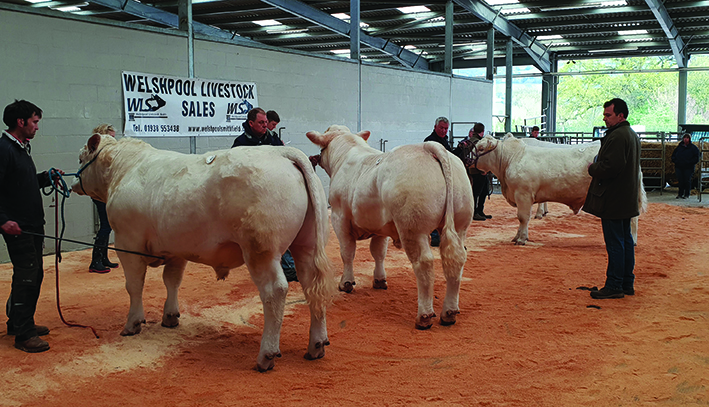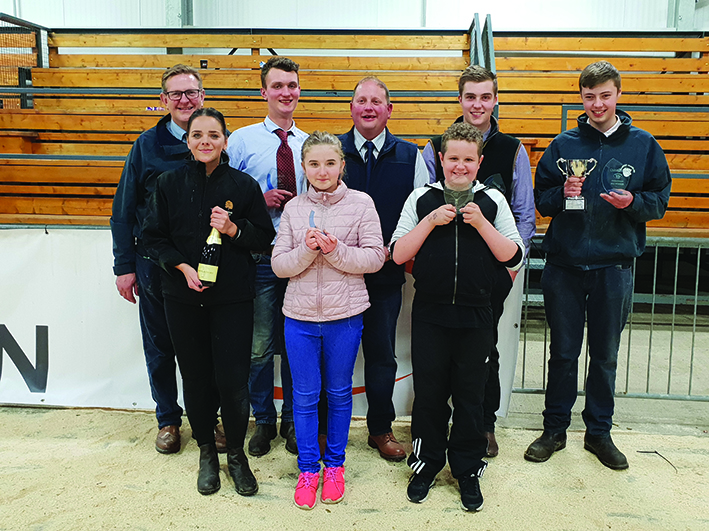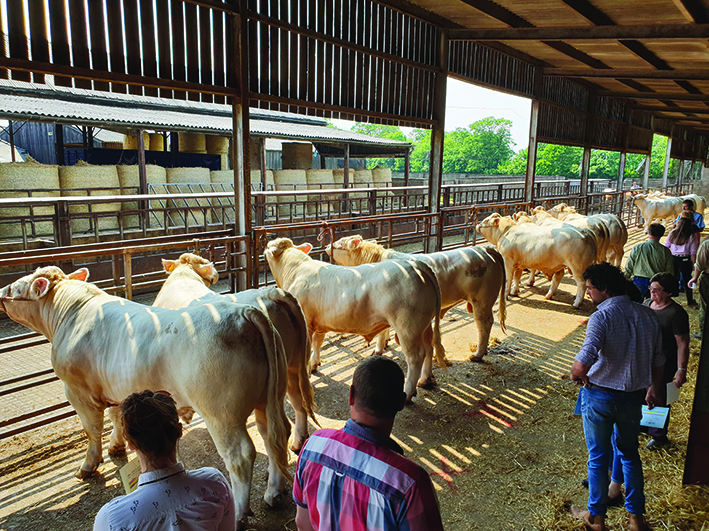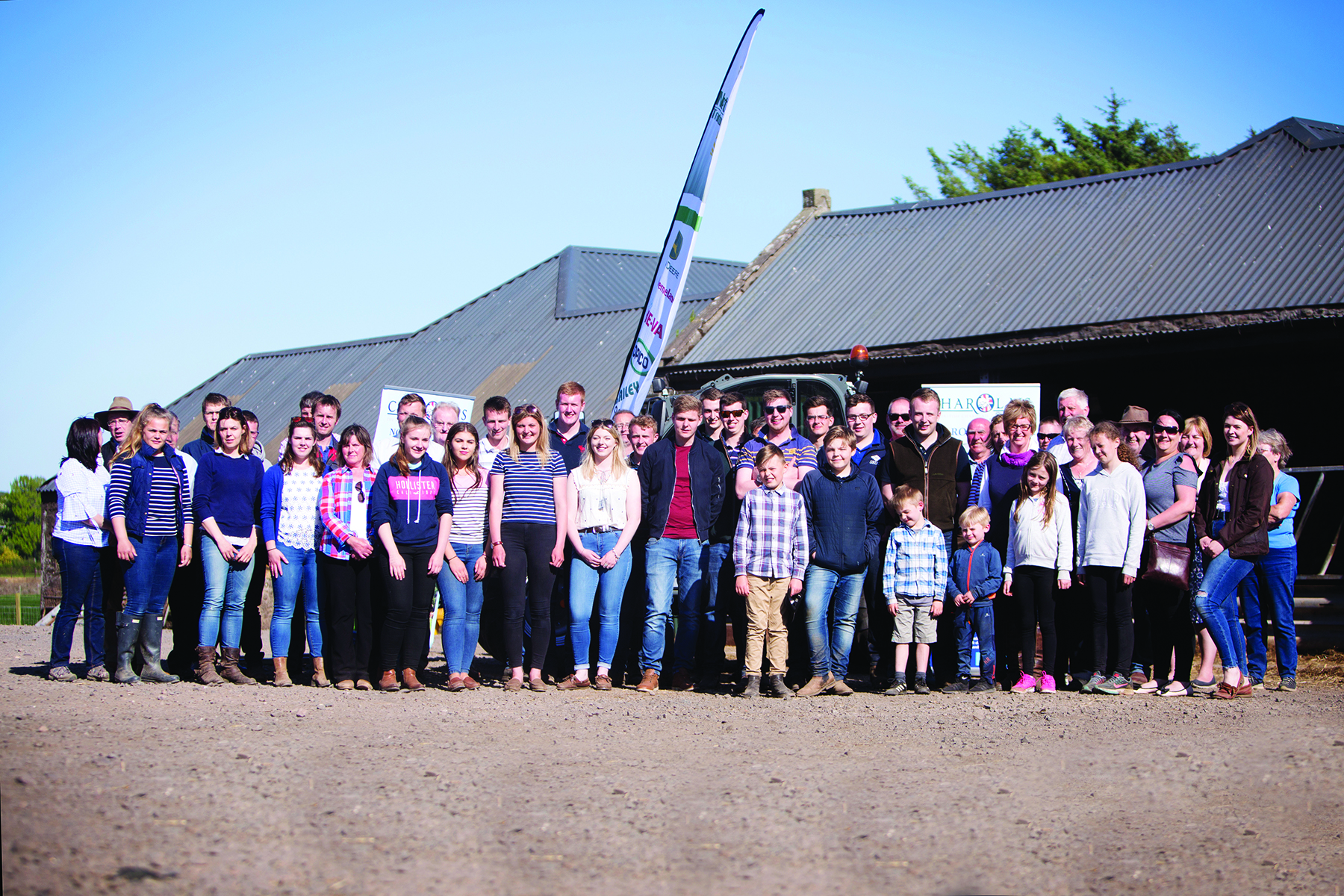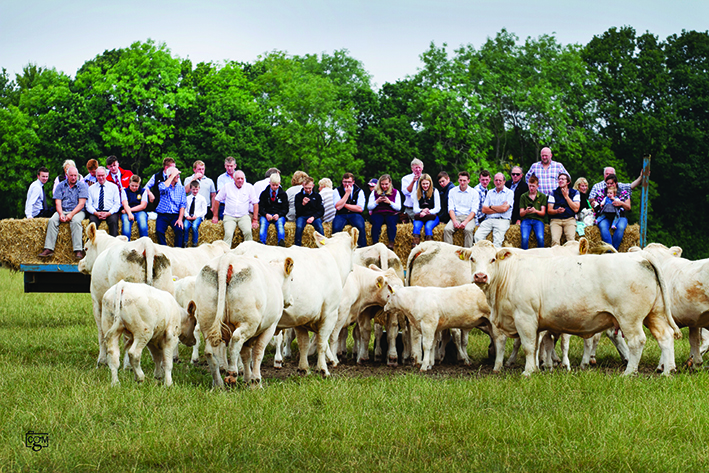South East, Anglia & South West Regional Qualifier

There was an early start to the qualifiers this year, as the weekend after Easter saw the first of the regional qualifiers take place for the South East, Anglia and South West regions on Saturday 7 April at Mortimers Farm, Fair Oak, Hampshire, by kind invitation of the Piper and Maclean families.
Mortimers Farm which established their Charolais pedigree herd in 1983 with the purchase of seven pedigree Charolais females from the Monymusk herd, is well known throughout the show circuit as Charlie and the boys take their show team all over the country. They have achieved considerable success in all age groups at National and County Shows including Overall Supreme Championship at the Royal Highland, South of England and The Royal Bath & West – to name just a few, and bred the last ever Royal Show Champion Mortimers Urovision.
In the sale ring the herd has had seven Perth sale female champions, five of whom were sired by homebred Mortimers Josh and their current record high priced, was the sale of Mortimers Echo for 10,000gns at Stirling in February 2011.
Quality is favoured over quantity and the Mortimers’ breeding objective has been to produce quality females and bulls for pedigree herds and the commercial farmer – focusing on ease of calving, conformation, temperament, milk and growth rates. A high health and welfare policy is paramount, and the herd is a member of the SRUC Premium Cattle Health Scheme and accredited for BVD, IBR and Johnes.
After the club AGM, the stockjudging began with three classes to be judged, young heifers, cows and bulls. After which we tucked into the fine spread laid on by regional co-ordinator and host Karen Maclean, which included some very welcome warming soup. Lunch and the presentations were hosted in the beautiful period barn and when everyone had eaten their fill there was a chance to have a go at halter making with Graham Fishlock before a cattle dressing demonstration by experienced showmen Darren Knox of the Drumshane herd and host Charlie Maclean.
Before the presentation of prizes, the master judge 23-year-old Ruth Perry gave us a demonstration on how to give reasons and the young competitors had a chance to ask her questions about her choices, and her experiences in previous stockjudging competitions. It was refreshing to have such a young master judge and the high scores achieved by the competitors proved that she knew her stuff.
Congratulations to all of the regional high scorers who went forward to the National final on the 21st July. For the South East region, Angus Maclean and Kirstie Torrance will represent the seniors with scores of 142 & 132 respectively. Donald Maclean and Matthew Ranson who scored 134 & 106 will go forward at the intermediate team and Holly Archer and Kiera Mason go forward for the juniors with scores of 141 and 138. For Anglia, team A are Naomi Jones and Ellie Knox who scored 127 & 125, team B – Toby Ranson and Hannah Knox – 102 & 123 and team C – Charlie Knox scoring 123 and William Heath. And finally, the South West will be represented by James Wareham, George Wareham, Emily Mitchell, Ben Trim, Tom Mitchell and Ali Wareham who scored 113, 102, 136, 134, 130 & 112 respectively.
Wales & North Midlands
Regional qualifiers for the Welsh and Midlands regions were next, and this year was again held at Welshpool Livestock Market on the evening preceding the April society sale.
The stockjudging was scheduled for after the inspections and there was a small turnout with competitors travelling from Wales, the Midlands and even one from Yorkshire! The market had kindly agreed to us using the show ring and as usual the Welshpool market team were really accommodating, with the caterers staying on late so we could host the presentations in the canteen. The exhibitors were as always, ready and willing to help and between them organised two bull good classes for judging and Society Vice Chairman Ben Harman kindly stepped in as master judge.
After the judging, while the scoring was taking place, Society CEO Peter Phythian gave a presentation to competitors and exhibitors on cattle classification and market requirements, which was followed by a talk and a question and answer session on the Society’s new DNA policy.
Congratulations to Aimee Varga, Tom Brown, George Hollinshead, Imogen Roe, Cara Smith and Luke Allen-Pugh, who all qualified for a place at the National final.
Borders
The Border region qualifier was held with kind permission and sponsorship of Harrison & Hetherington at Borderway Mart, on the eve of the Spring Carlisle sale, on the first of what we hope to be an annual event held jointly with the British Blonde Society.
The evening kicked off at 7pm with the stockjudging of two classes of Charolais and a class of Blonde cattle, thanks must go to the exhibitors who even after a long day, kindly and happily bought their cattle out into the ring for the competitors to view. The master judge James Crichton explained what he was looking for to youngsters and locals who had turned out to take part. Betty Graham, Paul Stobart and the club organised a raffle, guess the weight competition and bar in aid of Hospice at Home and the local Air Ambulance, which ended up with healthy donations at the end of the evening.
While the scoring was taking place, the caterers laid on a hot beef roll and chips for all the attendees before Andrew Stott performed clipping demonstrations on both a Charolais and a Blonde heifer and the Society staff gave presentations similar to the ones at Welshpool before the winners were announced.
Well done to Euan Cunningham and Paul Gardner who qualified for the senior team and both scored 171 points, Harry Stobart and Ellie Stamper who qualified for the intermediate team with scores of 190 and 179 points respectively, and Jack Little scoring 152 and Cara Mitchell scoring 133 qualifying them for the junior team, for the National final in July.
Yorkshire & North East
The Yorkshire & North East area was the next to hold their qualifier, which was held for the second year running in Skelton on Ure, North Yorkshire, at Billy Turner’s Brampton herd. Brampton is one of the longest established Charolais herds in the country being started back in 1972 and has gone from strength to strength, with accolades including being awarded the Raymond Ogden Perpetual Trophy on its first outing in 1982, numerous Supreme Championships at the Perth bull sales and the Royal Show and most recently Brampton Nutella headed his class at this year’s National show. The Turners have also exported Charolais cattle all worldwide including consignments to Brazil, South Africa and Eire.
Stockman Michael and Antony had prepared three handsome classes of cattle and the Master Judge Harvey Wood made his choices before the competitors took their turn. Club secretary Margaret Atkinson arranged the scoring and the presentations were made at Billy and daughter Sarah’s home in the village, where we were treated to a pork batch supper with plenty of cakes for pud.
Qualifying for the final were seniors Jordan Tipping who scored 118 and Joe Speak with 115 points, intermediates Charlie Hitchen with 114 points and Sam Watson scoring 108 points and juniors Sophie and Rebecca Hitchen who scored 212 and 105 respectively.
Scotland
May bank holiday weekend saw the Scottish and Northern club qualifier hosted at Firhills Farm in Arbroath, Angus by kind invitation of Jim Muirhead. The family had pulled out all of the stops to make it a great day, with a fantastic show of cattle and a fabulous spread.
The Firhills herd was established in 1971 when Jim’s father Dave joined the Society to grade up his commercial herd using Charolais semen as at the time graded up Charolais bulls were selling for around £1,000 per head. Jim bought his first pedigree Charolais – Kingsmuir Teresa – in 1989, and later followed this with the purchase of Stirling Mia when John Hornall sold his herd prior Andrew taking over.
Jim’s daughter Alison who helps manage the herd is an active member of the Scottish and Northern club and has previously served as club secretary, while Jim is a seasoned show judge, with his last major appointment judging the beef interbreed pairs at the Highland Show in 2016. The herd current consists 30 breeding cows, nine in-calf heifers and nine bulling heifers, with four bulls going up to Stirling in October. Looking to the future Jim would like to increase his cow count to 40 now that he has reached a stage where he can more selectively breed for type. The 380 acre holding also boasts a healthy arable enterprise producing potatoes, sprouts, peas, barley and wheat.
The herds show highlights include attaining female and reserve supreme champion at the Highland show last year with the home-bred Firhills lady and in 2013 they were awarded the male and reserve supreme champion with the stock bull they share with Major Walter – Maerdy Grenadier, who is still producing for the herd, alongside their other stock bulls shared with the Panmure and Glenericht herds.
On the beautiful bank holiday Sunday, after Master judge Matthew Milne had made his choices, the day began with the stock judging and Jim, Alison and family had organised four classes of penned cattle for the competitors to look over. After which we were treated to burger and hotdogs from the BBQ and a massive choice of cakes and luscious strawberries from the farm next door, while regional co-ordinator Karyn McArthur organised reason giving and John Graham stepped in to score.
Prior to the afternoons presentations where Edward Scott, Claire McIldowie, Lois Scott, Rory Milne and Millie MacKenzie qualified to go forward to the final, we were treated to clipping and dressing demonstration by Allen Drysdale, a talk on managing females to maximise nutrition by Dr Alistair Crozier, director of Parkside Vets, Dundee, and a talk on nutrition by David MacKenzie from Harbro.
Northern Ireland
It was a great day for the Northern Ireland Charolais Youth regional qualifier which was hosted by kind permission of Swatragh Mart as an added feature of the sale on Friday 1st June.
The qualifier took place throughout the evening with nearly 40 competitors aged between eight and 26, taking part to try to secure one of the 10 regional places on offer at the final at Seawell Grounds, Northamptonshire on the 21st July.
The competitors were asked to judge three classes of cattle, two classes of heifers which were kindly supplied by Robert McWilliams and Douglas Morrow, and a class of bulls kindly provided by Jonathan Crawford. The sale judge Gary Henderson was the master judge for the competition and judging from the scores of the competitors did a good job on his placings.
Top placed in the senior section was James Rea with an impressive 147 points, while the section’s runner up was Eimear McGovern who scored 145. The intermediate winner Mark Reid was also the evenings top scorer who placed the whole bunch correctly achieving maximum points of 150. The intermediate runner up with 130 points was Ryan Doyle. The junior winner Conor Phair is just eight years old and must already what he’s looking for as he scored 148 points, just behind on 143 was the junior runner-up Andrew Hamel. Joining the winners at the final will be next highest placed competitors Kevin Reavey and Alan Burleigh who both scored 145 points, Andrew Dunn on 140 and Bartley Finnegan who scored 139. Thanks to CIP Insurance Brokers Ltd who supported the event by giving travel bursaries to the young people enabling them to compete in the UK finals.
Open Day & Charolais Youth National Final
Charolais members and their families from the Midlands made the most of a sunny day by visiting former President, Pete Donger’s, Seawell Farm near Towcester in Northampton in the height of the drought in July.
Although the grass was yellow, and little re-growth looked likely, visitors commented on how well the cattle looked as they boarded a farm trailer and toured the farm.
It was a full day and the visitors were split into three groups which alternated activities to make the most of the mornings programme. While one group set out with host Peter to tour his impressive holding, a second listened to Barbara Webster of Pedigree Cattle Services explain the benefits of EBV’s, while the third group were given a talk on DNA and genomics by Paul Flynn of Weatherbys.
Lunch was served to the visitors while the Charolais Youth finalists got on with the task of making their selections in the four classes of cattle head stockman Andrew and his team had selected for the stock judging classes. After which while the senior and intermediate competitors gave their reasons to the other judges, the juniors were talked through how to assess a heifer by Master Judge Steven Nesbitt of the Alwent herd. As a new element to the final they then filled out a basic assessment on another heifer, giving them a chance to start to learn about reason giving and animal assessments.
The afternoon was just as full with a clipping and dressing demonstration from Richard Davies, a talk on Nutrition by Christopher Barclay and David MacKenzie from Harbro and demonstration by Denis Dreux from Intouch, Keenan. The visitors also had a chance to chat with Szymon Nowaczek from Caisley Tags, one of the sponsors who came down for the day.
The afternoon climaxed with the presentations of the awards for the stockjudging final and it was great to see youngsters from all over the UK with such enthusiasm for the Charolais breed. The Senior section winner and runner up and also joint winners of the Pairs Fairway Trophy, who will be visiting the French National Charolais show in Poitiers in September were Kevin Reavey, 25 of the Jerretspass Charolais herd, and Alan Drysdale, 23 of Derryharney Charolais both from Ireland with impressive scores of 238 & 216 points respectively. Both Kevin and Alan are keen Charolais Youth participants and Kevin was selected to become the first Clogher show shadow judge, while Alan has represented the Society as part of the Young Show Stars team in 2016.
The Intermediate section was headed by 17 year old Scottish competitor Edward Scott with 219 points and 16 year old South West representative Emily Mitchell’s score of 204 secured her the runner up position.
The Scottish and Ireland regions were also the homes of the top placing juniors. The highest placed and delighted junior winner with a score of 232 points, was 13 year old Rory Milne who had travelled down to the competition with his grandad and new Society President Archie Macgregor. While second placed junior Andrew Hamil, a 14 year old from Dunmurry, Belfast scored 220. Joining Rory in second place in the team competition was 14 year old Millie MacKenzie, also from Scotland contributing 212 points to their overall total of 444.
More about Seawell….
Peter farms a total of 1700 acres and grows 1200 acres of cereals. He retains the barley on-farm for feed, sells the rape to a local chicken farm on a private contract, grows oats for seed and splits the wheat acreage with half going for milling and the other half also going to the local chicken farm.
He keeps just over 400 acres in grass, with 60 to 80 acres of maize for silage, and splits the grass into two-year leys for silage and five-year leys for grazing with some permanent pasture.
“I’ve had Charolais cattle since the 70’s, but it was in 1983 that I started to take the breed really seriously and made the decision to use the Charolais as my terminal sire,” he says. “I’ve always been a weight man – weight of the animal at slaughter – that’s where the money is, and there’s no doubt this is where the breed wins time and time again.”
Pete runs 130 pedigree Charolais cows in single suckler herds, keeping between 15 and 20 animals and their calves in each group. He also has around 200 Salers in suckler herds as well, and with youngstock and growing bulls has more than 1000 animals on-farm at any one time.
“The Salers have good maternal traits, they are also easy-calving when put to Charolais bulls, give lots of milk and bring longevity into the dairy cross. We never have to touch them at calving.”
He has quickly gained a reputation for having some top bulls for sale privately, and says this side of the farm business is growing every year. Those not sold privately go to auction at Newark, or are sold to the trade for meat.
“The Charolais will grow to 750kgs in no time at all, that’s my aim, and they’re great converters, doing well on our grass and maize rations. I look for a good topline, good feet, legs and movement and enough of a backend.”
Most of his Charolais sales are to the beef boys, and he says some customers will come along and buy 12 to 15 bulls at a time. “Bull sales is where the real value of the job is, so I have to get this part of the job right,” he says. “Selection is key and watching how each animal grows and develops to understand its traits and value.”
With Salers he says the value is in the female, with a lot of producers wanting Saler females so they can put a Charolais bull on for extra weight gain. In the past 12 months in particular, since dairy farmers have seen that the more modern Charolais bull results in an easy-calving cross, he’s seen more interest from milk producers across the country, something supported by the higher bull prices reflected this spring.
He has five current stock bulls. One of his favourites is Maurdo Flambeau, now nine years-old, who passes on great size into his females with fast growth rates. Then there’s Ballsaec Maestron, the youngest bull at two years, Ballsaec Jonathon and Mardi Jimbucca both three-year olds, and Hi Flyer at Seven.
With his pedigree cows Pete tries to keep the average herd age around six, yet says if they stay fit he will keep breeding from them.
Seawell Farm is a true family business, and Pete was keen to tell his guests of the important role his wife, Sheelagh, plays in running the operation. “I couldn’t do this without her,” he says. She looks after the huge and growing mound of paperwork, from cattle passports to bills. One of the most frustrating parts of the job is how the administration element of the job increases every year.
Praise for the British Charolais Cattle Society came from Barbara Webster of Pedigree Cattle Services in Perth, one of several speakers on the day. She said the Society was the most active in completing herd inspections, and stressed how important this was.
“If I had a single message it would be for farmers to weigh all cattle. And that means weighing the poorer animals too. We need highs and lows to see where the breed is going. A lot of breeders will only weigh the stock going to the sales, and this will mask the figures we all come to rely on,” she says.
Barbara also pointed out that figures were only part of the story – that they ignore traits such as mobility and jaws, and that 30% come from genetics and 70% from environment.
“The British Charolais Cattle Society is one of the most progressive,” she told visitors. “Be honest with yourselves, be aware of herd weaknesses, have a breeding objective and chose bulls that rectify issues or weaknesses. Make good use of herd reports and graphs.
“I’ve seen calving ease improve dramatically, fat cover improve and marbling, making this an ideal butchers’ animal. But always remember, the bull is only half the story, he is only putting half his DNA into the offspring.”
The Society would like to thank the Donger family, Andrew and the team for hosting this incredible day. Special thanks to also our sponsors Weatherbys, Harbro, Keenan Feeders, Dungannon Mart, Welshpool Livestock Sales, Caisley Tags, Newark Livestock Market, Rugby Farmers Mart, Country Refreshments, Field Farm Tours and United Auctions. And to everyone who was involved with the organising of the event and helping out on the day – without all of you it would not have been possible – Master Judge Steven Nesbitt and Commercial Judge Mike Atkinson. Stewards Ben Harman, Chris Curry and David Benson. Speakers Barbara Webster, Paul Flynn, Richard Davies, Christopher Barclay, David MacKenzie and Denis Dreux. Scorers Margaret Atkinson and Donna Knox and welcoming committee Rhian and Amy Varga.
Categories: Charolais Youth
National Young Stars Northern Boys » « Clogher Show Bank of Ireland NI National Charolais Championship
